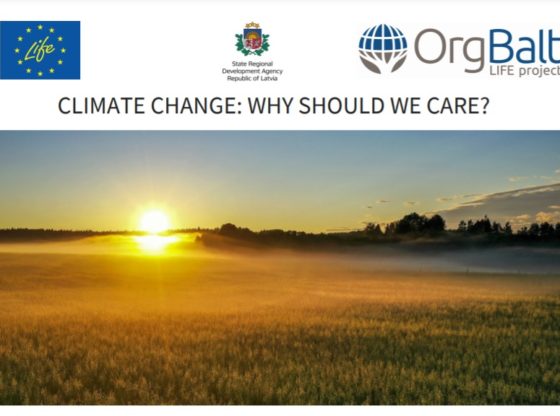The article “Climate change: why should we care?” has been prepared by the LIFE OrgBalt experts. In this article experts explain climate change causes and consequences by answering the following questions: What is climate change, what are driving causes, which are the main related challenges and what can be done to tackle them? Full article available: HERE.
What causes climate change?
The Earth’s atmosphere contains certain gases such as carbon dioxide (CO2), methane (CH4), ozone (O3), nitrous oxide (N2O), chlorofluorocarbons (CFC-11, CFC-12), that function like glass panels of a greenhouse letting sunlight passing the atmosphere. Solar light is then transformed on the earth’s surface into heat energy and reflected back into the atmosphere where it cannot pass the greenhouse gas “shield”. Human activities however increase the concentration of greenhouse gases in the atmosphere.
Among the main factors responsible for the rapid increase of GHG emissions in the atmosphere are anthropogenic GHG emissions from utilisation of fossil carbon resources like oil, gas, coal, and nutrient-rich organic soils.
What are the consequences of this human-driven climate change we are currently experiencing?
One of the main impacts of climate change is its multiple effects on water management with a clear impact on our health and the economy as well as on all freshwater dependent ecosystems. Global warming threatens fresh water availability and quality, promoting salinisation, growth of toxic algae and bacteria. This affects agriculture and forestry by: Preventing the growth of trees and crops; increasing pest attacks and extent wildfires and diminishing water availability and habitat variety. The rise in temperatures and droughts along with the lack of precipitation accelerates land degradation and loss of productive and fertile land and to increased vulnerability to desertification. Soil degradation in turn boosts climate change by increased GHG emissions, loss of moist and cooling landscape elements and accelerates desertification and loss of biodiversity.
On the other hand, climate change is expected to increase the frequency of floods and heavy rainstorms, due to an increase in peak precipitation events. In the last three decades river flooding has become a common natural disaster in Europe which along with storms have affected millions of people causing accidents and large economic losses.
Are we taking actions to tackle climate change?
With the Paris agreement, for the first time all world nations signed a binding agreement to combat climate change and adapt to its effects. Adopted by 196 Parties on 12 nd December 2015 and entered into force on 4th November 2016, the agreement commits all United Nations Framework Convention on Climate Change member countries to limit the global temperature increase (global warming) to well below 2 °C (preferably 1,5 °C) above the pre- industrial level. (1)
Europe plays a great role in this respect aiming to become the world’s first climate-neutral continent with the European Green Deal a roadmap to make the EU’s economy sustainable announced on 11st December 2019.
How can carbon neutrality be achieved?
To achieve climate neutrality, society therefore needs to shift from an industrial competing model that exploits fossil and other natural resources to a carbon neutral and cooperative model which focuses on closed and sustainable carbon cycles in order to restore the carbon balance. Land plays an important role in this process.
PLEAS READ THE FULL ARTICLE: HERE.
LIFE OrgBalt Team
The article has been produced with the financial support of the LIFE Programme of the European Union and the State Regional Development Agency of Latvia within the Project “Demonstration of climate change mitigation potential of nutrient rich organic soils in Baltic States and Finland” (LIFE OrgBalt, LIFE18 CCM/LV/001158)
The developed article reflects only the LIFE OrgBalt project beneficiaries’ view and the European Climate, Infrastructure and Environment Executive Agency is not responsible for any use that may be made of the information contained therein.


